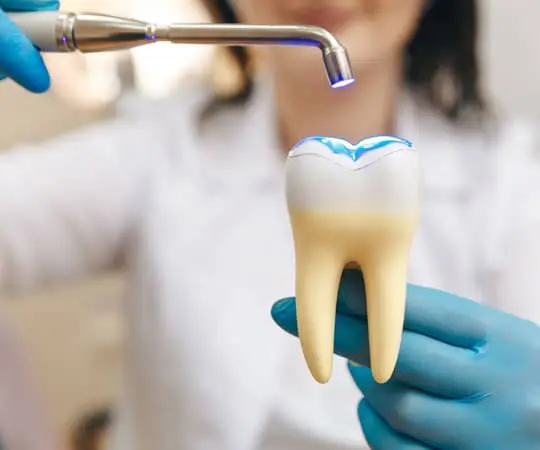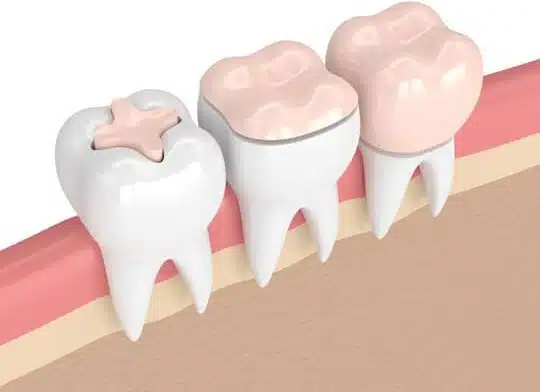
Composite Fillings in Bellevue, WA
If you’re dealing with cavities or minor cracks in your teeth, composite fillings offer a natural-looking, reliable way to restore your smile. At Bellevue Azalea Dentistry, we use high-quality, tooth-colored composite materials that blend seamlessly with your natural teeth while protecting them from further damage.
What Are Composite Fillings?
Composite fillings are a modern alternative to traditional metal fillings. Made from a mixture of powdered glass and composite resin, these fillings are ideal for small to medium-sized cavities and minor cosmetic repairs. They’re especially popular among patients who prefer a metal-free, natural-looking option.
Why Choose Composite Fillings?
There are several reasons why many patients opt for composite fillings:
- They match the color of your natural teeth.
- They bond directly to the tooth, strengthening the structure.
- Less drilling is needed, preserving more of your natural tooth.
- No metal means less risk of allergic reactions or sensitivity.
- They’re gentle on surrounding gum tissue and ideal for visible teeth.
Composite fillings are best for those who don’t regularly eat very sticky or hard foods and are looking for a clean, aesthetic solution.

What to Expect During the Dental Filling Procedure
Cavities are one of the most common dental concerns we see, often caused by bacteria, sugary foods, or poor oral hygiene. Anyone with teeth can get a cavity — but the good news is, they’re easily treatable with a simple dental restoration.
That restoration is a dental filling. If your dentist recommends one, it helps to know exactly what to expect. Being informed can make the process feel a lot less intimidating. Here’s how it works:
1. Examination and Diagnosis
Your dentist will start with a full exam to assess the condition of your teeth. If cavities or damage are detected, X-rays may be taken to get a closer look at the affected areas.
2. Shade Selection
To ensure your new filling blends in, your dentist will choose a composite shade that matches the natural color of your teeth. This step is especially important for visible areas of the mouth.
3. Numbing the Area
Local anesthesia is used to numb the tooth and surrounding gum tissue so you won’t feel any discomfort during the procedure. If you’re anxious, your dentist may discuss sedation options.
4. Tooth Preparation
The damaged or decayed portion of the tooth is removed. Sometimes, the tooth may need to be trimmed slightly to allow the filling to fit properly.
5. Etching and Bonding
Your dentist will apply a mild acidic solution to the tooth to create a rough surface. This allows the bonding agent to adhere more securely. A liquid bonding material is then applied.
6. Layering the Composite
The dentist applies the composite resin in layers. Each layer is shaped and then hardened using a special curing light. This step is repeated until the filling is built up to match your natural tooth structure.
7. Shaping and Polishing
Once the final layer is in place, your dentist trims and shapes the filling to ensure it fits your bite comfortably. The surface is then polished to give it a natural, smooth finish.
Composite Fillings vs. Other Types
We offer various types of fillings, but many patients choose composite for its aesthetic appeal and functionality. Unlike metal fillings, composite doesn’t contain mercury and doesn’t stand out when you smile.
How Long Do Composite Fillings Last?
With proper care and regular dental visits, composite fillings can last 5 to 10 years. You can help extend their lifespan by avoiding very hard or sticky foods and maintaining good oral hygiene.
Are Composite Fillings Safe?
Composite fillings are safe and widely used. While some patients express concern about BPA (a compound found in plastics), the levels in dental composites are extremely low and considered safe by dental health standards.
Aftercare for Composite Fillings
To get the most out of your fillings:
- Brush twice daily and floss regularly
- Avoid biting on hard objects like ice or pens
- Schedule regular checkups to monitor the integrity of your fillings
If your filling feels uneven or you notice sensitivity that persists, give us a call. We’ll be happy to make adjustments.
Final Thoughts
Cavities can happen to anyone, but treating them early with composite fillings is simple and effective. This tooth-colored solution not only restores function but also keeps your smile looking natural.
If you’re in need of a filling or have questions about your dental health, contact us at 425-998-8109 to book a consultation with Dr. Uparika Sharma at Bellevue Azalea Dentistry. We’ll walk you through every step and make sure you feel confident about your care.
Call today to schedule a consultation! (425) 998-8109
Call today to schedule a consultation!
(425) 998-8109
frequently asked question
How Soon Can I Eat After Composite Fillings?
Composite fillings have the advantage of hardening instantly. On the day you get your fillings done, you should eat soft, chewy foods and drink lots of fluid. Avoid anything hot, since it can harm the plastic component of the filling. After the anesthetic effects have worn off, you can resume your regular diet.
Can I Brush My Teeth After Composite Fillings?
You can brush your teeth a short while after getting a composite filling. After the substance has hardened, there’s no real threat to the fillings. However, you must be gentle while brushing and flossing. Use a brush with soft bristles and gently clean the filling when you need to.
